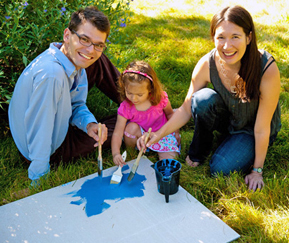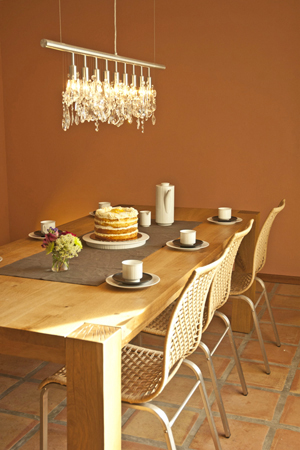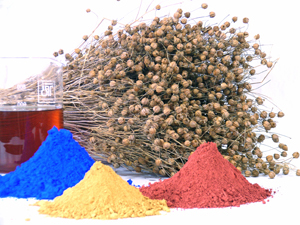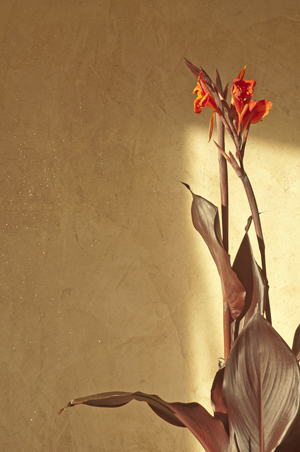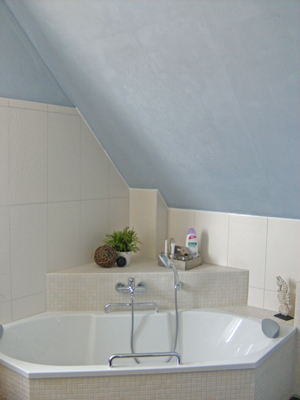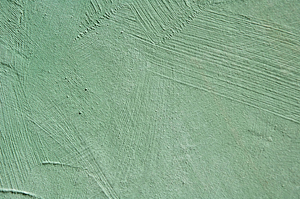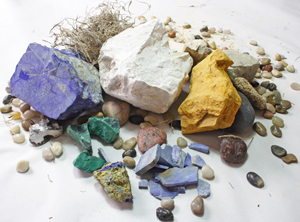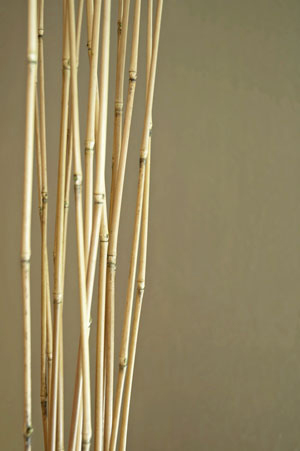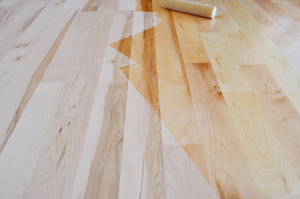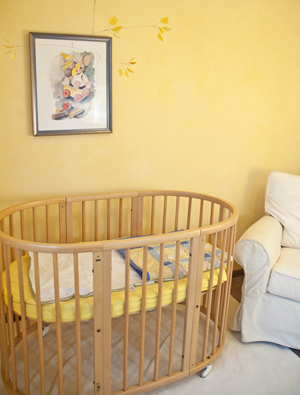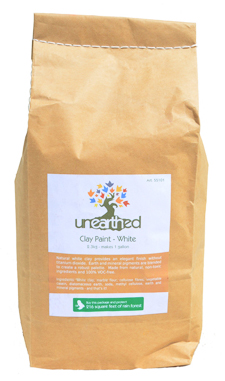
Have you ever tried to interpret the ingredients on the label of a can of paint or wood finish? Without a Material Safety Data Sheet, it isn’t easy. Paint companies are mandated to follow federal guidelines for disclosing ingredients, but that information can be hard for the layperson to understand, and you have to search for it.
In contrast, here’s what’s in a sack of Unearthed Paints Clay Paint: white clay, marble flour, cellulose fibers, vegetable casein, diatomaceous earth, soda, methyl cellulose and mineral pigments. Eight relatively intelligible ingredients — and they’re all listed on the bag.
“We’re very committed to ingredient transparency with all of our paint, plaster and wood finishing products,” says Jessica Pfohl, co-owner of Unearthed Paints. “We want people to know what they’re buying as well as what’s ecologically sustainable. That way, they can make responsible choices for their interior painting projects.”
Pfohl, an attorney, and her husband Florian Speier, a Swiss-trained architect, founded Unearthed Paints about a year ago in the hopes of bringing a variety of eco-friendly painting products from Germany to the U.S. So, from their home in Louisville, Colorado, the couple have become U.S. distributors for a company called Kreidezeit, which manufactures biodegradable, nontoxic and VOC-free paints in a small factory in Sehlem, Germany. (Speier is also a distributor of energy-efficient Zola Windows, manufactured in Poland.)
“Many people don’t realize that conventional off-the-shelf liquid paints are derived from crude oil. Making petroleum-based paint involves chemicals and significant processing, and that, in turn, requires a great deal of embodied energy. Every can of paint impacts the environment. Our products are different; we use natural mineral and earth pigments to color our paints, and the other components are minimally processed. In fact, most of what happens in our plant is mixing dry ingredients. That takes much less energy to manufacture, and none of it is petroleum-based,” Pfohl says.
Natural paints have been used for thousands of years by many cultures, including the Aboriginal people of Australia. Some of those paintings are more than 10,000 years old, thanks in part to the durability of naturally occurring earth and mineral pigments — ochers, sienna, umbers, spinels and ultramarines — plus simple compounds of clay, chalk and lime. Unearthed Paints are continuing these time-tested recipes in their product lines. They offer five varieties of interior paint, which are optimized for walls but could also work on wood. The company’s dry-mix Clay Paint, available in 12 colors, is suitable for absorbent surfaces such as plaster, concrete or drywall and dries to matte finish. Vega Paint, a powdered option that is based on ancient milk recipes, has been formulated to be dairy-free and is available in 24 colors that can be lightened to different shades. It also finishes to a matte appearance. The company’s Lime Paint ships in liquid form because its high alkaline content acts as a natural preservative. It can be mixed with any Unearthed Paint pigments to achieve a wide color spectrum. Unlike Clay or Vega paint, which are not intended for humid areas such as bathrooms or basements, Lime Paint is ideal for these applications because it resists mildew and algae growth. So is Gecko Paint, a fourth option. It is packaged as a liquid with great adhesion capabilities, so it will stick to most wall surfaces, including tile. Prices for these four options range from about $39 to $75 per mixed gallon.
“Our fifth paint — Plant Glue Paint — is our most affordable natural paint option, and it should suit any budget. It actually is designed with the capability of being washed off of walls, so it definitely isn’t the best choice for high traffic areas, but it’s great for ceilings. It’s commonly used for historic properties where layers and layers of paint would hide intricate Stucco work. We sell it for about $18 per gallon in dry form, and it can be mixed with any of our color pigments.”
Mineral and earth pigments, which Kreidezeit sources from various parts of the world, provide a range of rich, vibrant color options that Jessica says are difficult to duplicate chemically. There are about 100 paint shades in the current palette, and you can mix packets of pigment colors together to achieve other color possibilities, too. Learn more about earth and mineral pigments by clicking here.
If you’ve used milk paint on your woodworking projects, you’ll be familiar with the preparation process for using Unearthed Paints dry-blend products. The bag of bulk powered paint is mixed with water and a packet of pigment color that comes with it. Once the ingredients are blended — either with a drill and mixing paddle or even a handheld kitchen mixer — the liquid should rest for a recommended amount of time to activate the binding agents. Then, it’s ready for use. Pfohl says powdered paint offers a number of advantages: it extends the shelf life of the product and eliminates the need for the chemical preservatives that come in liquid, canned paints.
One user-friendly benefit that is common to synthetic paints is scrubbability. Natural paints can’t be scrubbed to the same degree as latex, but Pfohl points to different benefits instead. “Our paint doesn’t form the same film layer, so it’s breathable. You’ll never have the problems with peeling, cracking or mold growth with our paints, because moisture can escape through it. The paint, once applied, actually becomes more durable as it ages. And, you don’t have to take your leftover unused natural paint to a hazardous waste facility to dispose of it. Just let it dry and throw it away with the normal trash.”
In addition to the five paint options, Unearthed Paints also sells Clay Roll-on Plasters, natural primers and thinners and two products for finishing furniture or wood floors. One, called Hard Wax Oil, is a blend of linseed and tung oils, Carnauba wax and a resin. It contains no solvents or water yet is fluid, so it can be brushed, rolled or wiped on. Company literature says it’s a good alternative to polyurethane and forms a durable, matte finish that’s easy to spot repair. Safflower Wax, a second alternative, is a blend of beeswax, safflower and stand oils (aged linseed oil). While the Hard Wax Oil imparts a honey hue to the wood, Safflower Wax does not, which could be beneficial for preserving the blond coloration of maple or pine. It’s also solvent and VOC-free.
Florian and Jessica are proud of the fact that Kreidezeit is a carbon-neutral factory, and Unearthed Paints uses energy efficient, carbon-offset shipping practices to bring products overseas. “We also offer a rainforest pledge: for every square foot of paint, plaster or wood finish you buy, we will purchase one square foot of rainforest in the Chaco Forest of Paraguay and donate it back to the indigenous people who live there so it can be preserved,” Pfohl adds.
In the future, Unearthed Paints hopes to manufacture the products here in the States to eliminate the need for global shipping and further reduce the carbon footprint of their natural paints and other offerings. But that will depend on how successful these products become with consumers. And that could take a change in the mindset we have about where we buy our paints and what our expectations are of the companies that produce them.
“Improving awareness is very important to us. Before we started this business, I didn’t actually paint much. I thought of paint as smelly, and the desire to change a room color was never great enough for me to want to deal with the chemicals in conventional paints. Now I can paint my home and be reassured that I’m using a safe, sustainable and earth-friendly product. We want our customers to share in that confidence.”
